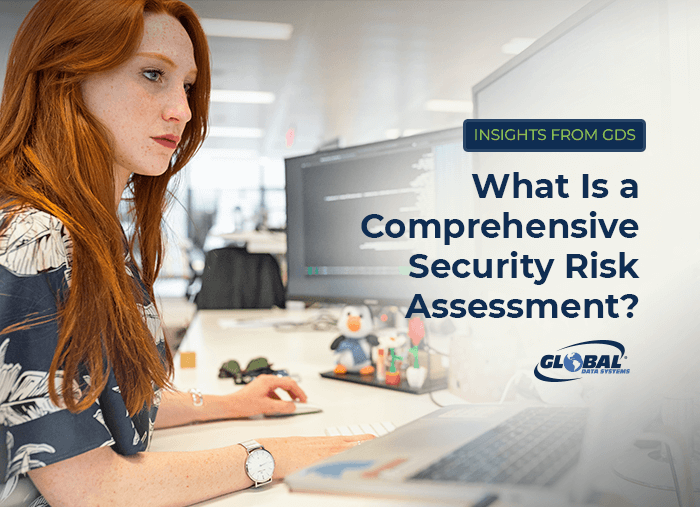What Is a Comprehensive Security Risk Assessment?
CFO tells us that 75% of security professionals have observed an increase in cyberattacks over the past year. These attacks have a major price tag attached. The global average cost of a data breach in 2023 was $4.45 million, a 15% increase over three years, highlighting the growing financial burden on organizations, according to IBM.

If you think these statistics don’t apply to you, you’re not alone. It’s an age-old story: Organizations take action to reduce risk after they fall victim to a security incident. In numerous surveys, organizations that suffer a cyberattack admit to implementing needed security controls after the fact.
That’s clearly not a sensible approach, but it’s easy for organizations to become overwhelmed by the sheer scope of cyber threats. Few know where to begin or what security investments will deliver the most value.
According to Forbes, global cybercrime damage costs are expected to grow by 15% per year over the next two years, reaching $10.5 trillion USD annually by 2025. Taking these cyber threats seriously can’t be pushed off any longer. That’s why a security risk assessment is vital to any company, in any industry, and of any size. A comprehensive cyber security risk assessment provides critical information that executives and IT leaders need to develop effective cybersecurity measures. However, the assessment process remains largely misunderstood.
Risk Assessments Commonly Misunderstood
Comprehensive security risk assessments help organizations identify vulnerabilities and prioritize actions to mitigate risks. Because the threat landscape changes constantly, assessments must be performed regularly to keep pace. However, studies from research giant Gartner find that organizations often go years between assessments, typically treating them as just another item to be checked off a to-do list.
In other cases, organizations simply don’t understand what’s required. Companies frequently say they do regular assessments when they are only doing vulnerability scans with off-the-shelf software. There’s a big difference. Vulnerability scans are just one element of a comprehensive assessment, and they only identify known threats. What’s more, off-the-shelf scanning software is not entirely reliable and in-house staff often lack the expertise to analyze the results.
NIST Guidelines for Cyber Security Risk Assessments
While there is no single standard assessment protocol, the National Institute of Standards and Technology (NIST) defines it as a multi-stage process designed to identify threats to the organization, internal and external vulnerabilities, the likelihood that these vulnerabilities will be exploited, and the degree of damage such exploits are likely to inflict.
Posture Assessment
This foundational step helps organizations understand what security measures they have in place, what they’re missing and what they should do to improve their security posture. It is more of a business assessment than a technical assessment, meant to provide clarity and direction. The assessment team conducts interviews, evaluates physical security, and reviews policies and procedures to provide the information needed to create a concrete action plan for security improvements.
Vulnerability Assessment
A comprehensive security risk assessment is essential for identifying vulnerabilities and developing effective cybersecurity measures to proactively reduce risks.
Vulnerability assessments include running internal and external network scans to find known weaknesses. Because of the limitations of off-the-shelf software, managed security service providers (MSSPs) use multiple professional-grade tools to provide comparative results and minimize false positives. The results are summarized in a detailed report describing found vulnerabilities, how they might be exploited, and how that might affect the organization’s security posture. The report should also include specific recommendations for addressing all issues discovered.
Penetration Testing
While the first two phases help identify potential problems, penetration testing demonstrates how vulnerabilities can be exploited and the damage likely to occur. Penetration tests, also known as pen tests or ethical hacking, are authorized attacks on the network. “White hat” hackers attempt to breach systems using brute-force attacks and other exploits to identify weaknesses. Typically, they will scan ports for possible attack vectors, evaluate patching processes, and test firewalls and other perimeter defense mechanisms.
How GDS Can Help With Risk Assessment in Cyber Security
GDS delivers vulnerability and risk assessment services to help organizations identify gaps in the security environment and prioritize investments. We can customize each engagement based on the organization’s IT environment, regulatory requirements and other factors. However, continuity is key. We also offer a monthly subscription service that continuously monitors IT assets and detects vulnerabilities.
For organizations looking to safeguard their operations against evolving cyber threats and ensure robust security measures, booking time with the GDS team for a personalized IT security risk assessment is highly recommended. By engaging with our team, you can gain insights into your unique security risks, tailor-made strategies for mitigation, and proactive measures to enhance your overall cybersecurity posture.
Don't wait for threats to compromise your systems — take proactive steps today to protect your organization's valuable assets and maintain trust with stakeholders. Contact us to schedule your consultation and embark on a journey towards fortified security and resilience!
Benefits of Managed IT Services from Global Data Systems
- Strategic Managed IT: We help you solve your technology related business problems.
- Connectivity: We get you reliable, secure connectivity anywhere in the western hemisphere in 48 hours.
- Support: When you need help simply call our 24x7x365 support number.
- Billing: Instead of managing hundreds of vendors - get one, easy to read bill from GDS.
Contact Managed Services Provider, Global Data Systems >

